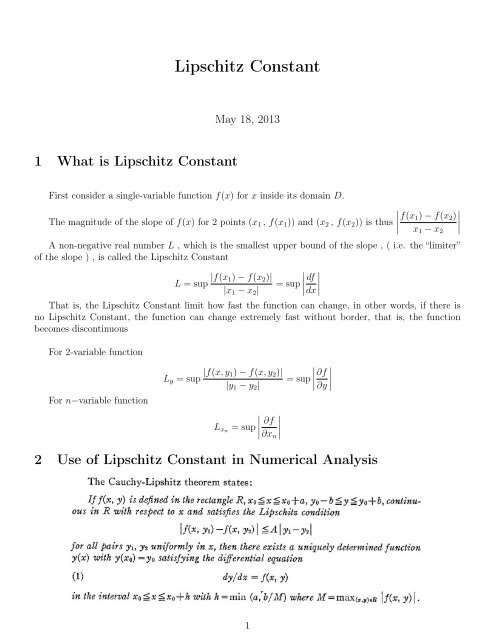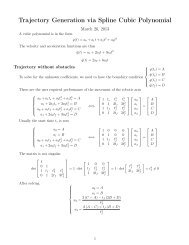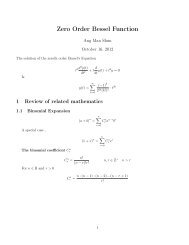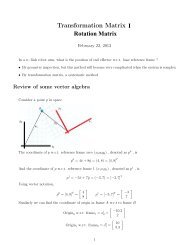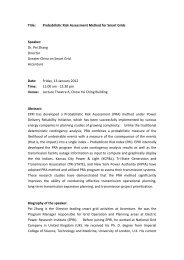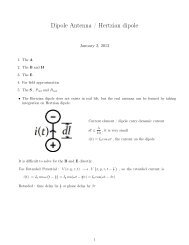Lipschitz Constant
Lipschitz Constant
Lipschitz Constant
Create successful ePaper yourself
Turn your PDF publications into a flip-book with our unique Google optimized e-Paper software.
<strong>Lipschitz</strong> <strong>Constant</strong><br />
May 18, 2013<br />
1 What is <strong>Lipschitz</strong> <strong>Constant</strong><br />
First consider a single-variable function f(x) for x inside its domain D.<br />
∣ The magnitude of the slope of f(x) for 2 points (x 1 , f(x 1 )) and (x 2 , f(x 2 )) is thus<br />
f(x 1 ) − f(x 2 ) ∣∣∣<br />
∣ x 1 − x 2<br />
A non-negative real number L , which is the smallest upper bound of the slope , ( i.e. the “limiter”<br />
of the slope ) , is called the <strong>Lipschitz</strong> <strong>Constant</strong><br />
L = sup |f(x 1) − f(x 2 )|<br />
= sup<br />
df<br />
|x 1 − x 2 | ∣dx∣<br />
That is, the <strong>Lipschitz</strong> <strong>Constant</strong> limit how fast the function can change, in other words, if there is<br />
no <strong>Lipschitz</strong> <strong>Constant</strong>, the function can change extremely fast without border, that is, the function<br />
becomes discontinuous<br />
For 2-variable function<br />
For n−variable function<br />
L y = sup |f(x, y 1) − f(x, y 2 )|<br />
|y 1 − y 2 |<br />
∣ L xn = sup<br />
∂f ∣∣∣<br />
∣∂x n<br />
= sup<br />
∂f<br />
∣ ∂y ∣<br />
2 Use of <strong>Lipschitz</strong> <strong>Constant</strong> in Numerical Analysis<br />
1
3 Computation of <strong>Lipschitz</strong> <strong>Constant</strong><br />
The <strong>Lipschitz</strong> <strong>Constant</strong> can be found using definition or triangle-inequality<br />
EXAMPLE<br />
f = |y|<br />
EXAMPLE<br />
f = √ |y|<br />
∣ L = sup<br />
∂f<br />
∣∣∣ ∣ ∂y ∣ = sup ∂y ∣ ∂y ∣ = sup 1 = 1<br />
∣ L = sup<br />
∂f<br />
∣∣∣∣ ∣ ∂y ∣ = sup ∂ √ |y|<br />
∂y ∣ = sup √ 1 = ∞ /∈ R +<br />
|y|<br />
Thus there is no <strong>Lipschitz</strong> <strong>Constant</strong><br />
EXAMPLE<br />
f = x 2 y , x ∈ [−5, 2] , y ∈ [3, ∞]<br />
L = sup<br />
∂f<br />
∣ ∂y ∣ = sup ∣ ∣ x<br />
2 = 25<br />
EXAMPLE<br />
f = √ x 2 + y 2 √ √<br />
|f(x, y 1 ) − f(x, y 2 )| = | x 2 + y1 2 − x 2 + y2|<br />
2<br />
√ √<br />
√ =<br />
∣ x 2 + y1 2 − x 2 + y2<br />
2 ∣ ·<br />
x2 + y1 2 + √ x 2 + y2<br />
√ 2 x2 + y2 2 + √ x 2 + y2<br />
2<br />
=<br />
≤<br />
=<br />
|y 2 1 − y 2 2|<br />
√<br />
x2 + y 2 2 + √ x 2 + y 2 2<br />
|y 1 + y 2 |<br />
√<br />
x2 + y2 2 + √ |y 1 − y 2 |<br />
x 2 + y2<br />
2<br />
|y 1 | + |y 2 |<br />
√<br />
x2 + y2 2 + √ |y 1 − y 2 |<br />
x 2 + y2<br />
2 } {{ }<br />
≤1<br />
Thus L = 1<br />
≤ 1 · |y 1 − y 2 |<br />
−END−<br />
2


